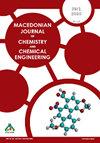茶水提取物的特性及其在不同化学成分织物染色和功能化中的应用
IF 0.6
4区 化学
Q3 CHEMISTRY, MULTIDISCIPLINARY
Macedonian Journal of Chemistry and Chemical Engineering
Pub Date : 2023-12-25
DOI:10.20450/mjcce.2023.2698
引用次数: 0
摘要
制备了绿茶、红茶、路依布斯茶和芙蓉茶(GT、BT、RT 和 HT)水提取物,并对其总黄酮(TFC)和总酚(TPC)含量以及抗氧化和抗菌活性进行了表征。BT 的总黄酮含量最高,而 HT 的总酚类含量最低(1213 vs. 415 mg l-1),提取物的总酚类含量(2283 - 7251 mg l-1)依次降低:BT>GT>RT>HT。根据 DPPH 和 ABTS 方法测定,它们的抗氧化活性分别为 78.1 - 93.1%和 97.8 - 100%。BT 尤其是 GT 水提取物对几种微生物具有温和的作用。所有检测的提取物都对羊毛、醋酸纤维素、聚酰胺和棉花具有染色亲和力,其染色强度值为 1.65-19.12。用 GT 水提取物功能化的羊毛、聚丙烯腈、聚酯、聚酰胺、棉花和醋酸纤维素能抑制金黄色葡萄球菌和大肠杆菌的生长,而聚丙烯腈和棉花也能分别抑制粪肠球菌和白喉杆菌的生长。用 BT 水提取物功能化的织物对金黄色葡萄球菌的抑制区很宽。一般来说,所研究的织物显示出非常高(81.60 - 100%)的 ABTS 自由基清除能力,与所使用的提取物无关。TPC 与 DPPH 法测定的羊毛和聚丙烯腈的抗氧化活性具有良好的线性关系。用 GT 或 BT 水提取物对不同化学成分进行染色和/或功能化处理的织物可用于生产具有治疗、预防和保护功能的高附加值医用纺织品。它们在伤口治疗方面具有潜在的应用价值,尤其是在容易感染金黄色葡萄球菌的皮肤伤口方面。此外,使用 GT 或 BT 水提取物功能化的羊毛和棉花还可用于一次性医用纺织品,如伤口愈合过程中使用的绷带和纱布。本文章由计算机程序翻译,如有差异,请以英文原文为准。
Characterization of tea water extracts and their utilization for dyeing and functionalization of fabrics of different chemical compositions
Green, black, rooibos, and hibiscus tea (GT, BT, RT, and HT) aqueous extracts were prepared and characterized in terms of total flavonoids (TFC) and total phenolic (TPC) contents and antioxidant and antimicrobial activities. BT has the highest, while HT has the lowest TFC (1213 vs. 415 mg l–1), while the extracts’ TPCs (2283 – 7251 mg l–1) decreased in the following order: BT > GT > RT > HT. Their antioxidant activities of 78.1 – 93.1% and 97.8 – 100% were determined according to DPPH and ABTS methods, respectively. BT and especially GT aqueous extracts possessed mild effects against several microorganisms. All examined extracts have an affinity for dyeing wool, cellulose acetate, polyamide, and cotton, which is proven by the color strength values of 1.65–19.12. Wool, polyacrylonitrile, polyester, polyamide, cotton, and cellulose acetate functionalized with GT aqueous extract inhibited the growth of S. aureus and E. coli, while polyacrylonitrile and cotton also inhibited the growth of E. faecalis, and C. albicans, respectively. Wide inhibition zones for S. aureus were observed for fabrics functionalized with BT aqueous extract. Generally, the investigated fabrics showed very high (81.60 – 100%) ABTS radical scavenging ability independent of the extract used. TPCs have good linear correlations with the antioxidant activities of wool and polyacrylonitrile determined by the DPPH method. Fabrics with different chemical compositions dyed and/or functionalized with GT or BT aqueous extracts can be used to produce high-value-added medical textiles with therapeutic, prophylactic, and protective functions. They can find potential applications in wound treatment, especially in skin wounds that are susceptible to infection with S. aureus. Moreover, wool and cotton functionalized with GT or BT aqueous extract can also be considered for use in disposable medical textiles like bandages and gauze used in the wound-healing process.
求助全文
通过发布文献求助,成功后即可免费获取论文全文。
去求助
来源期刊
CiteScore
1.60
自引率
20.00%
发文量
14
审稿时长
>12 weeks
期刊介绍:
Macedonian Journal of Chemistry and Chemical Engineering (Maced. J. Chem. Chem. Eng.) is an official publication of the Society of Chemists and Technologists of Macedonia. It is a not-for-profit open acess journal published twice a year. The journal publishes original scientific papers, short communications, reviews and educational papers from all fields of chemistry, chemical engineering, food technology, biotechnology and material sciences, metallurgy and related fields. The papers published in the Journal are summarized in Chemical Abstracts.

 求助内容:
求助内容: 应助结果提醒方式:
应助结果提醒方式:


